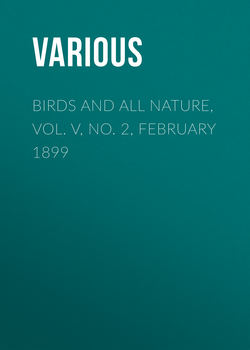Читать книгу Birds and all Nature, Vol. V, No. 2, February 1899 - Various - Страница 4
THE CRAB-EATING OPOSSUM
ОглавлениеTHE crab-eating opossum (Philander philander) is one of the largest of the family. The body is nine and one-half inches long, and the tail nearly thirteen inches. It has a wide range, extending throughout all of tropical America. It is numerous in the woods of Brazil, preferring the proximity of swamps, which furnish it with crabs. It lives almost exclusively in trees, and descends to the ground only when it wishes to forage.
While it proceeds slowly and awkwardly on the ground, its prehensile tail enables it to climb trees with some facility. This opossum readily entraps smaller mammals, reptiles, and insects, and especially crabs, which are its favorite food. It preys upon birds and their nests, but it also eats fruit, and is said to visit poultry yards and to cause great devastation among chickens and pigeons.
The young of the crab-eating opossum differ in color from the old animals. They are completely naked at birth, but when they are sufficiently developed to leave the pouch, they grow a short, silky fur of a shining nut-brown color, which gradually deepens into the dark brownish-black color of maturity. All observers agree that the little creatures escape from the pouch and, moving around and upon the mother's body, afford a charming spectacle. The pouch is formed by two folds of skin, which are laid over the unformed young attached to the mammae.
The opossum is extensively hunted on account of the havoc it works among poultry.
The negroes are its enemies, and kill it whenever and wherever they can. The flesh is said to be unpalatable to most white persons, for two glands impart a very strong and repellent odor of garlic to it, but the negroes like it, and the flesh repays them for the trouble of the pursuit. The opossum, however, is not easily killed, and resorts to dissimulation when hard pressed, rolls up like a ball, and feigns to be dead. To anyone not acquainted with its habits, the open jaws, the extended tongue, the dimmed eyes would be ample confirmation of it, but the experienced observer knows that it is only "'possuming," and that as soon as the enemy withdraws it will gradually get on its legs and make for the woods.
It is said that the opossum was formerly found in Europe, but now only inhabits America. Nearly all of the species live in the forest or in the underbrush, making their homes in hollow trees, holes in the ground, among thick grass and in bushes. All are nocturnal in their habits and lead a solitary, roving life. The opossum lives with its mate only during the pairing time. It has no fixed habitation. In captivity it is the least interesting of animals. Rolled up and motionless, it lies all day, and only when provoked does it make the slightest movement. It opens its mouth as wide as possible, and for as long a time as one stands before it, as if it suffered from lockjaw.
The opossum can hardly be classed among the game animals of America, yet its pursuit in the South in old plantation days used to afford the staple amusement for the dusky toilers of the cotton states. It was the custom, as often as the late fall days brought with them the ripened fruit and golden grain, for the dark population of the plantation, sometimes accompanied by young "massa," to have a grand 'possum hunt a la mode. We would describe the method of taking it, were it the policy of this magazine to show approval of a most cruel practice. Happily the custom, through change of circumstances, has fallen into disuse.
The specimen of this interesting animal which we present in this number of Birds and All Nature was captured, with its mother and five young ones, in a car load of bananas, having traveled all the way from the tropics to Chicago in a crate of the fruit. The mother and young were kept alive by eating the bananas, another proof that the crab-eating opossum does not feed exclusively upon animal food.
